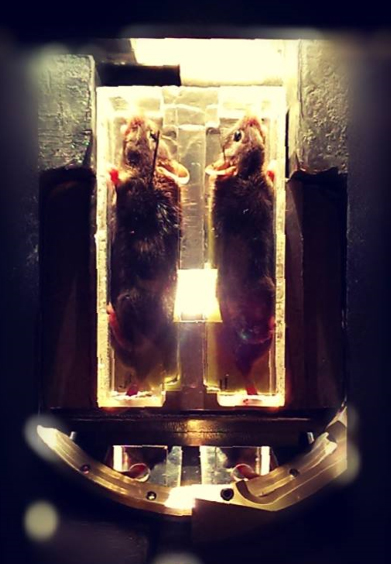글로벌 연구동향
방사선생물학
- [Int J Radiat Oncol Biol Phys.] Effects of ultra-high dose rate FLASH irradiation on the tumor microenvironment in Lewis lung carcinoma: role of myosin light chain
서울대 / 김영은, 안지완*
- 출처
- Int J Radiat Oncol Biol Phys.
- 등재일
- 2020 Nov 10
- 저널이슈번호
- S0360-3016(20)34500-4. doi: 10.1016/j.ijrobp.2020.11.012.
- 내용
Abstract
Purpose: To investigate whether the vascular collapse in tumors by conventional dose rate (CONV) irradiation (IR) would also occur by the ultra-high dose rate FLASH IR.Methods and materials: Lewis lung carcinoma (LLC) were subcutaneously implanted in mice followed by CONV or FLASH IR at 15 Gy. Tumors were harvested at 6 or 48 hr post-IR and stained for CD31, phosphorylated myosin-light chain (p-MLC), γH2AX, intracellular reactive oxygen species (ROS), or immune cells such as myeloid and CD8α T cells. Cell lines were irradiated with CONV IR for Western blot analyses. ML-7 was intraperitoneally administered daily to LLC-bearing mice for 7 days prior to 15 Gy CONV IR. Tumors were similarly harvested and analyzed as above.
Results: By immunostaining, we observed that CONV IR at 6 hr post-IR resulted in constricted vessel morphology, increased expression of phosphorylated myosin light chain (p-MLC), and much higher numbers of γH2AX (surrogate marker for DNA double strand break)-positive cells in tumors, which were not observed with FLASH IR. Mechanistically, we found that MLC activation by reactive oxygen species (ROS) is unlikely since FLASH IR produced significantly higher ROS than CONV IR in tumors. In vitro studies demonstrated that ML-7, an inhibitor of MLC kinase abrogated IR-induced γH2AX formation and disappearance kinetics. Lastly, we observed that CONV IR when combined with ML-7 produced some effects similar to FLASH IR including the reduction in the vasculature collapse, fewer γH2AX-positive cells, and increased immune cell influx to the tumors.
Conclusions: FLASH IR produced novel changes in the tumor microenvironment that were not observed with CONV IR. We believe that MLC activation in tumors may be responsible for some of those microenvironmental changes differentially regulated between CONV and FLASH IR.

Affiliations
Young-Eun Kim 1 , Seung-Hee Gwak 1 , Beom-Ju Hong 2 , Jung-Min Oh 2 , Hyung-Seok Choi 1 , Myeong Su Kim 3 , Dawit Oh 3 , Fred Lartey 4 , Marjan Rafat 4 , Emil Schüler 5 , Hyo-Soo Kim 6 , Rie von Eyben 4 , Irving L Weissman 7 , Cameron J Koch 8 , Peter G Maxim 4 , Billy W Loo 9 , G-One Ahn 10
1 Department of Life Science, Pohang 37673, Gyeongbuk, Korea.
2 Division of Integrative Biosciences and Biotechnology, Pohang University of Science and Technology (POSTECH), Pohang 37673, Gyeongbuk, Korea.
3 College of Veterinary Medicine, Seoul National University, Seoul 08826, Korea.
4 Department of Radiation Oncology Stanford University School of Medicine, Stanford, CA94305, USA.
5 Department of Radiation Oncology Stanford University School of Medicine, Stanford, CA94305, USA; Department of Radiation Physics, The University of Texas MD Anderson Cancer Center, Houston, TX77030, USA.
6 Department of Internal Medicine, Seoul National University College of Medicine, Seoul 03080, Korea.
7 Institute of Stem Cell and Regenerative Medicine, Stanford University School of Medicine, Stanford, CA94305, USA.
8 Department of Radiation Oncology, University of Pennsylvania School of Medicine, PA19104, USA.
9 Department of Radiation Oncology Stanford University School of Medicine, Stanford, CA94305, USA. Electronic address: bwloo@stanford.edu.
10 College of Veterinary Medicine, Seoul National University, Seoul 08826, Korea. Electronic address: goneahn@snu.ac.kr.
- 키워드
- DNA damage and repair; FLASH; ionizing radiation; tumor microenvironment; tumor vasculature.
- 연구소개
- 본 논문은 미국 스탠포드 그룹과 스위스 그룹에서만 수행하고 있는, 최신 방사선 기법인 초고속 방사선 조사 ‘FLASH’를 사용하여 종양 내 미세 환경 변화를 관찰한 논문입니다. 제가 포항공대에 재직하였을 당시 저희 대학원생이었던 홍범주 학생이 스탠포드 대학교에 방문하여 본 실험을 진행함으로써 첫 스타트를 끊게 된 연구로써, FLASH는 기존의 방사선 기법보다 20배 정도 빨리 방사선량을 전달하게 되는데, 물리적으로 보면 같은 선량을 속도만 달리하여 전달하는 것이기 때문에 별 차이가 없어보이지만, 최근 연구 결과에 의하면 FLASH 방사선 조사 기법을 사용하면 정상 조직 손상이 획기적으로 줄어든다는 논문들이 많이 보고 되고 있습니다. 저희는 정상 조직에서 한 걸음 더 나아가 종양 내에서는 어떠한 일들이 일어나는지를 관찰하였습니다. 최근 저희 논문에 의하면, 고선량 방사선 직후에 종양 내 혈관이 급격히 수축하는 현상을 관찰하였는데, 본 연구에서 FLASH 방사선 조사 기법을 사용 해 보니 이러한 현상이 관찰되지 않았습니다. 국내에서는 FLASH 방사선 조사 기법을 (구축하려는 그룹들은 있으나, 아직 구축이 안되었기에) 사용할 수 없으므로, 기존의 방사선에서 일어나지만 FLASH에서 일어나지 않는 현상들을 이해한다면, FLASH 방사선을 쓰지 않고도 FLASH 효과를 유도할 수 있지 않을까 하는 생각을 하였습니다. 이에 기존의 방사선에 의해 유도되는 혈관 수축은 세포 수축에 관여하는 인자인 myosin light chain의 활성화 때문이라는 것을 알게 되었고, myosin light chain 억제제와 기존의 방사선 조사 기법을 병용하면, 종양 내에서 FLASH 방사선을 조사한 것 과 같은 효과를 보이는 미세 환경 요소들을 관찰 할 수 있었습니다.
- 덧글달기
- 이전글 [J Ginseng Res.] Ginsenoside-Rp1 inhibits radiation-induced effects in lipopolysaccharide-stimulated J774A.1 macrophages and suppresses phenotypic variation in CT26 colon cancer cells
- 다음글 [Biochem Biophys Res Commun.] Radiation-induced IL-1β expression and secretion promote cancer cell migration/invasion via activation of the NF-κB-RIP1 pathway










편집위원
FLASH 방사선 치료법 활ㅇ요한 생물학적 특성 규명함.
2021-01-05 16:58:38